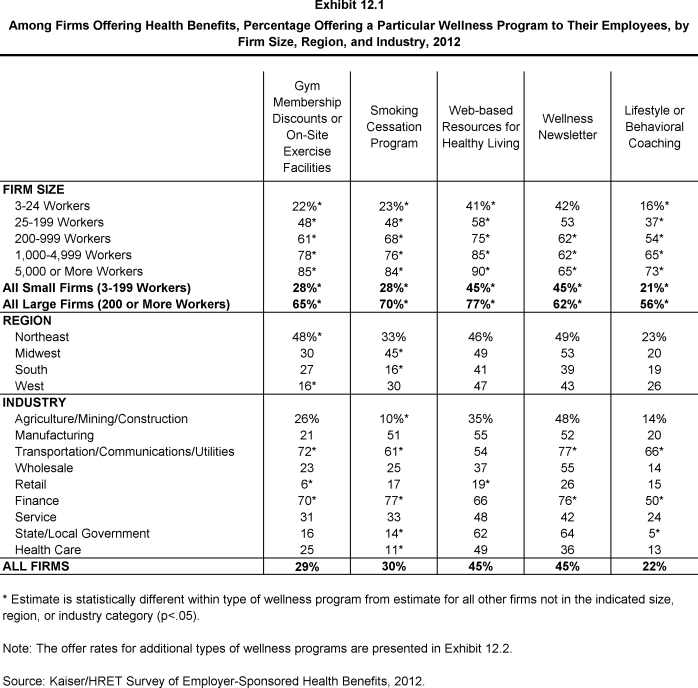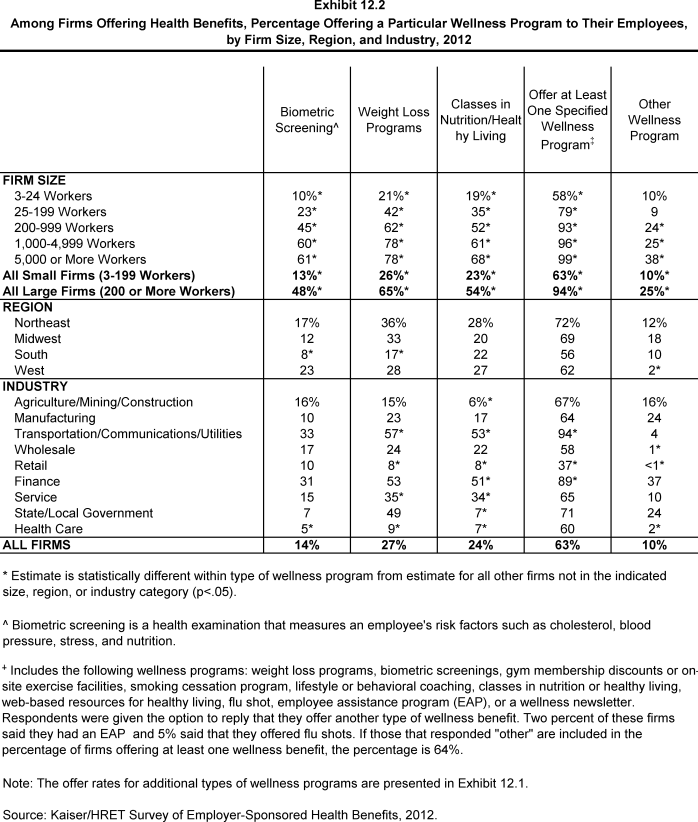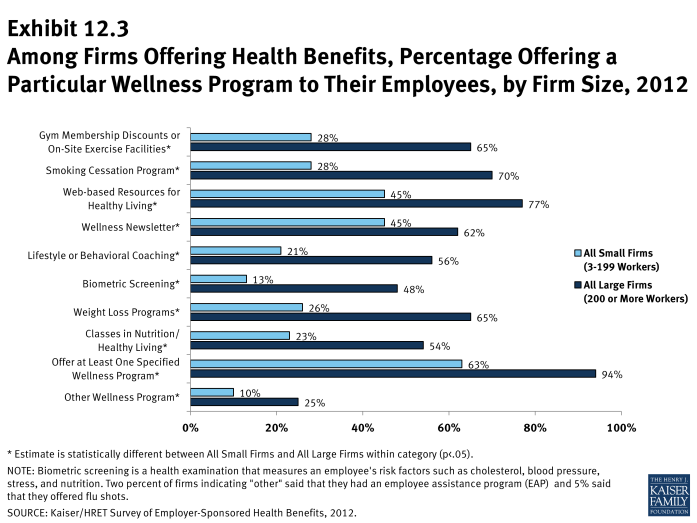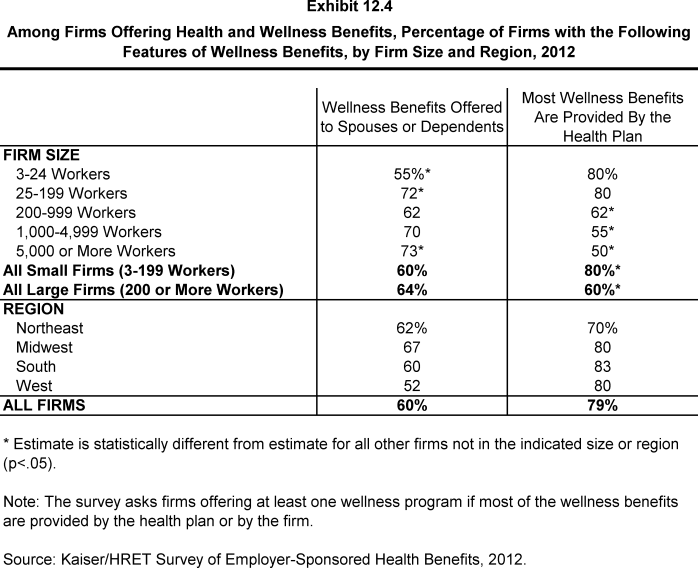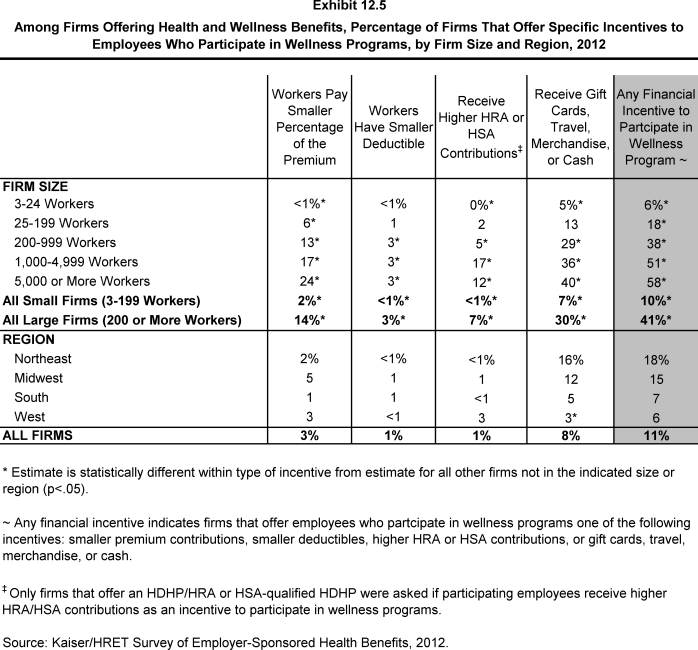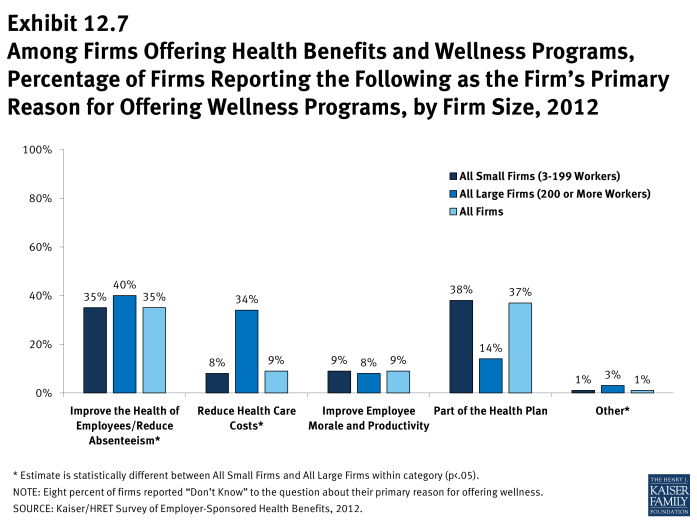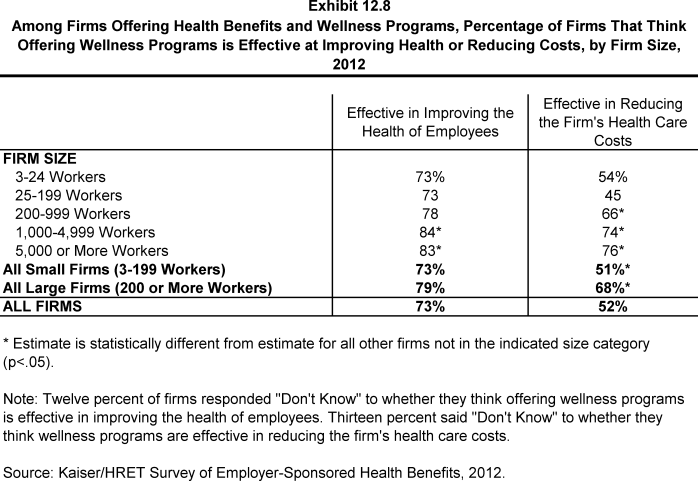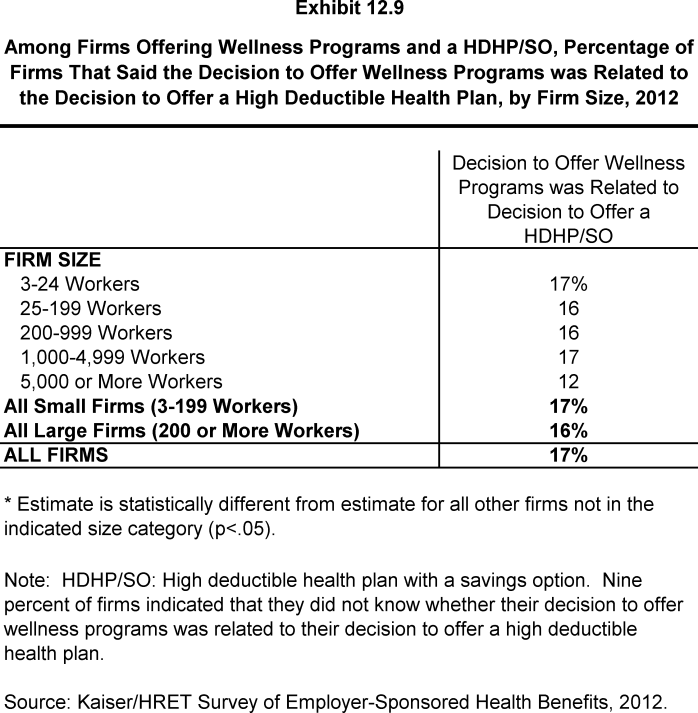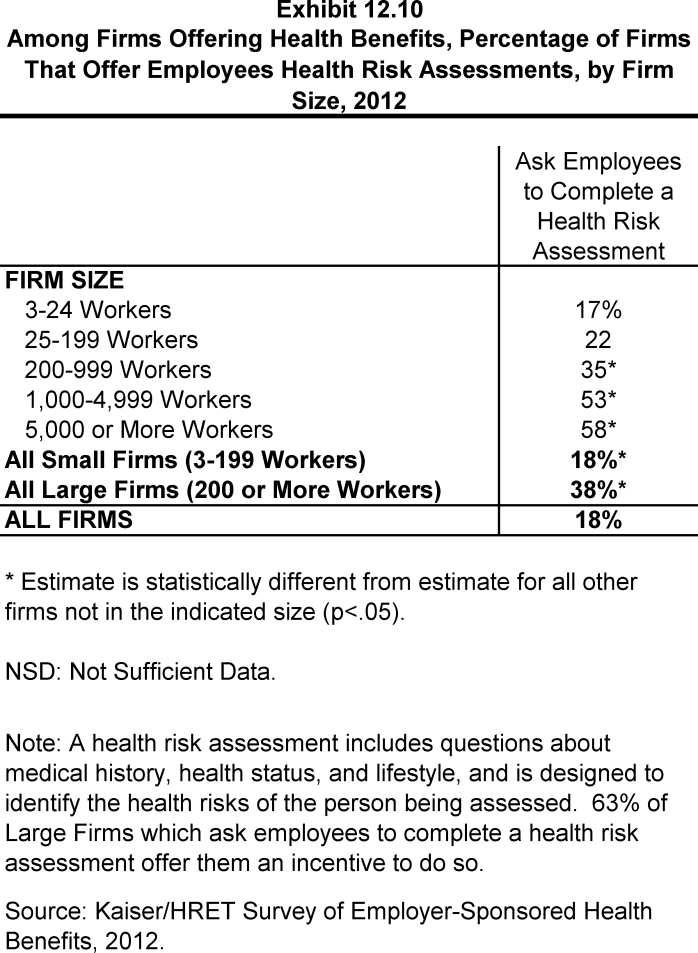2012 Employer Health Benefits Survey
Section 12: Wellness Programs and Health Risk Assessments
A majority of firms offering health benefits offers some type of wellness program, with large firms (200 or more workers) being more likely than smaller firms (3-199 workers) to offer a wellness benefit. Forty-one percent of large firms and 10% of small firms offering at least one wellness benefit offer financial incentives to employees who participate in wellness programs. Eighteen percent of firms ask employees to complete health risk assessments, with some of these firms tying financial penalties or rewards to employees who complete wellness programs or meet biometric outcomes.
Wellness Benefits
- For a variety of reasons including efforts to improve health and lower costs, some employers and health plans offer wellness programs. Wellness programs may range from classes in nutrition or healthy living to a wellness newsletter.
- Sixty-three percent of firms offering health benefits offer at least one of the following wellness programs:
- weight loss programs
- biometric screening
- smoking cessation programs
- lifestyle or behavioral coaching
- gym membership discounts or on-site exercise facilities
- classes in nutrition or healthy living
- web-based resources for healthy living
- a wellness newsletter 1
- Large firms (200 or more workers) are more likely to offer at least one of the listed wellness programs than smaller firms (94% vs. 63%). The offer rate for each type of wellness benefit included in the survey is presented in (Exhibit 12.1), (Exhibit 12.2) and (Exhibit 12.3)
- Sixty percent of firms offering health benefits and wellness benefits offer the wellness benefits to spouses or dependents (Exhibit 12.4)
- Sixty-three percent of firms offering health benefits offer at least one of the following wellness programs:
- In order to encourage participation in wellness programs, firms may offer financial incentives to employees who participate.2
- Eight percent of firms offering health benefits and at least one of the listed wellness programs offer gift cards, travel, merchandise, or cash to workers who participate in wellness programs. Large firms (200 or more workers) are more likely to offer these incentives than small firms (3-199 workers) (30% vs. 7%) (Exhibit 12.5).
- Few firms offering health benefits and at least one of the listed wellness programs lower worker premium contributions (3%) or cost sharing (1%) as an incentive to encourage employees to participate. Among firms that offer a high-deductible plan paired with a HRA or HSA, 1% of firms offer workers who participate in wellness programs higher HSA or HRA contributions than employees who do not participate (Exhibit 12.5).
- Ten percent of small firms and 41% of large firms offering one or more of the listed wellness programs offer employees a specific incentive for enrolling in wellness programs3 (Exhibit 12.5).
Encouraging Participation in Wellness Programs
- Firms use methods such as health fairs or health claims that identify health risks to identify individuals and encourage participation in wellness programs.
- Twenty-four percent of firms offering health benefits and at least one of the listed wellness programs report using health fairs to identify individuals and encourage participation in wellness programs; this is a significant increase over the 9% of firms reporting using health fairs in 2011. Large firms (200 or more workers) are more likely than small firms (3-199 workers) to use health fairs to encourage wellness participation (44% vs. 23%) (Exhibit 12.6).
- Forty-six percent of firms offering health benefits and at least one of the listed wellness programs use health risk assessments to identify individuals and encourage wellness participation (Exhibit 12.6).
Reasons for Offering Wellness Programs
- Firms offering health benefits and at least one of the listed wellness programs were asked to identify their primary reason for offering a wellness program. Thirty-seven percent cite as their primary reason that the wellness program was part of their health plan, while an almost equal percentage (35%) say their primary reason is to improve the health of employees and reduce absenteeism. Fewer firms identify improving morale and productivity (9%) or reducing health costs (9%) as their primary reason (Exhibit 12.7).
- Large firms (200 or more workers) are more likely than smaller firms to report that reducing health care costs (34% vs. 8%) is a primary reason for offering wellness programs, while small firms (3 to 199) workers are more likely than larger firms to say that their primary reason for offering a wellness program was because it was part of the health plan (38% vs. 14%) (Exhibit 12.7).4
- Among firms offering an HDHP/SO and at least one of the listed wellness benefits, 17% report that their decision to offer a wellness program was related to their decision to offer a high-deductible health plan (Exhibit 12.9).5
- Among firms offering health benefits and at least one of the listed wellness programs, 73% think offering wellness programs is effective in improving the health of the firms employees. Fifty-two percent of firms offering health coverage and at least one of the listed wellness programs think offering wellness programs is effective in reducing their firms health care costs. Large firms are more likely than small firms to think offering wellness programs is effective in reducing health care costs (68% vs. 51%) (Exhibit 12.8).6
- Among firms offering health benefits and at least one wellness program, 79% report that most of the wellness benefits they offer are provided by the health plan (Exhibit 12.4).7 Small firms (3 to 199 workers) are more likely than larger firms to report that most wellness programs are provided by the health plan (80% vs. 60%) (Exhibit 12.4).
Health Risk Assessments
- Some firms give their employees the option of completing a health risk assessment to identify potential health risks. Health risk assessments generally include questions about medical history, health status, and lifestyle.
- Overall, 18% of firms offering health benefits ask their employees to complete a health risk assessment. Large firms (200 or more workers) are more likely than smaller firms to offer employees this option (38% vs. 18%) (Exhibit 12.10).
- Some firms offer financial incentives to encourage employees to complete health risk assessments.
- Of those large firms (200 or more workers) offering health benefits and health risk assessments, 63% offer a financial incentive to employees who complete a health risk assessment.8
- Of those large firms (200 or more workers) offering health benefits and health risk assessments, 63% offer a financial incentive to employees who complete a health risk assessment.8
- This year, firms who ask employees to complete a health risk assessment were also asked if their employees are rewarded or penalized financially for completing a wellness or health management program or meeting biometric outcomes.
- Eleven percent of large firms (200 or more workers) reported that there are instances where an employee with an identified health risk factor is required to complete a wellness or health management program or activity in order to avoid a financial penalty such as a higher premium contribution or higher patient cost sharing.9
- Nine percent of large firms (200 or more workers) who ask their employees to complete a health risk assessment reported that employees are rewarded or penalized financially based on whether they meet specified biometric outcomes (not including smoking cessation), such as meeting a target body mass index (or BMI) or cholesterol level.10
- Eleven percent of large firms (200 or more workers) reported that there are instances where an employee with an identified health risk factor is required to complete a wellness or health management program or activity in order to avoid a financial penalty such as a higher premium contribution or higher patient cost sharing.9
x
Exhibit 12.1
x
Exhibit 12.2
x
Exhibit 12.3
x
Exhibit 12.4
x
Exhibit 12.5
x
Exhibit 12.6
x
Exhibit 12.7
x
Exhibit 12.9
x
Exhibit 12.8
x

